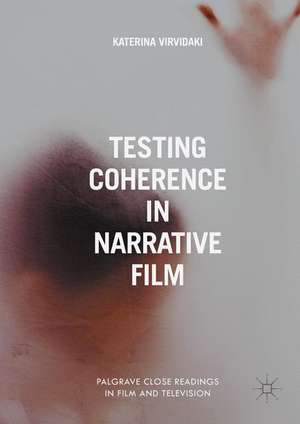Testing Coherence in Narrative Film: Palgrave Close Readings in Film and Television
Autor Katerina Virvidakien Limba Engleză Hardback – 23 oct 2017
This book examines the concept of coherence in film studies. It asks if there are ways to appreciate the achievement of coherence in narrative films that are characterised by an eccentric or difficult style, as well as by an apparently confusing intelligibility. In order to answer this critical question, the author argues that we need to reconsider the predominant understanding of the concept of coherence in film studies. Virvidaki identifies how a general function of coherence is manifested through the aesthetic of transparency and unobtrusiveness of classical Hollywood film. The author then proceeds to a close analysis of stylistically perplexing narrative films, in order to demonstrate how we can broaden, expand and readjust the classical criteria of coherence. Testing Coherence in Narrative Film will appeal to film and philosophy scholars interested in aesthetics and narrative form.
| Toate formatele și edițiile | Preț | Express |
|---|---|---|
| Paperback (1) | 409.89 lei 38-44 zile | |
| Springer International Publishing – 24 aug 2018 | 409.89 lei 38-44 zile | |
| Hardback (1) | 644.18 lei 6-8 săpt. | |
| Springer International Publishing – 23 oct 2017 | 644.18 lei 6-8 săpt. |
Preț: 644.18 lei
Preț vechi: 757.85 lei
-15% Nou
Puncte Express: 966
Preț estimativ în valută:
123.30€ • 133.98$ • 103.64£
123.30€ • 133.98$ • 103.64£
Carte tipărită la comandă
Livrare economică 21 aprilie-05 mai
Preluare comenzi: 021 569.72.76
Specificații
ISBN-13: 9783319621951
ISBN-10: 3319621955
Pagini: 218
Ilustrații: IX, 218 p. 12 illus.
Dimensiuni: 148 x 210 mm
Greutate: 0.52 kg
Ediția:1st ed. 2017
Editura: Springer International Publishing
Colecția Palgrave Macmillan
Seria Palgrave Close Readings in Film and Television
Locul publicării:Cham, Switzerland
ISBN-10: 3319621955
Pagini: 218
Ilustrații: IX, 218 p. 12 illus.
Dimensiuni: 148 x 210 mm
Greutate: 0.52 kg
Ediția:1st ed. 2017
Editura: Springer International Publishing
Colecția Palgrave Macmillan
Seria Palgrave Close Readings in Film and Television
Locul publicării:Cham, Switzerland
Cuprins
1. Introduction: Is ‘Coherence’ Just a Style?.- 2. PART I - Chapter 2: Interrogating Problems of Coherence in Narrative Film.- 3. The Elusive: Max Ophuls’ Madame De….- 4. PART II - Chapter 4: The Unbelievable: Carl-Theodor Dreyer’s Ordet.- 5. The Fragmented: Jean-Luc Godard’s Passion.- 6. The Digressive: Quentin Tarantino’s Pulp Fiction.- 7. The Inexpressible: Terrence Malick’s The Thin Red Line.- 8. Conclusion.
Notă biografică
Katerina Virvidaki completed her D.Phil. in English (Film Studies) at the University of Oxford in 2015. She has taught Philosophical Aesthetics at The National Technical University of Athens (Department of Humanities, Social Sciences and Law) and she has also been working as a curriculum developer, organising educational programs on art and philosophy (The American College of Greece, Pierce College). She currently teaches Film and Adult Education at the Hellenic Open University (Master’s in Adult Education M.Ed.).
Textul de pe ultima copertă
This book examines the concept of coherence in film studies. It asks if there are ways to appreciate the achievement of coherence in narrative films that are characterised by an eccentric or difficult style, as well as by an apparently confusing intelligibility. In order to answer this critical question, the author argues that we need to reconsider the predominant understanding of the concept of coherence in film studies. Virvidaki identifies how a general function of coherence is manifested through the aesthetic of transparency and unobtrusiveness of classical Hollywood film. The author then proceeds to a close analysis of stylistically perplexing narrative films, in order to demonstrate how we can broaden, expand and readjust the classical criteria of coherence. Testing Coherence in Narrative Film will appeal to film and philosophy scholars interested in aesthetics and narrative form.
Caracteristici
Considers the notion of coherence in narrative film as an aesthetic achievement Dissociates coherence from a specific model, period or tradition of film, arguing that a productive critical concept of coherence in film studies can and must be based on an exploratory and variegated understanding of the concept’s workings Draws together a range of very different films, from Max Ophuls’ classically structured Madame de… to Jean-Luc Godard’s ‘radical’ Passion and Quentin Tarantino’s seminal Pulp Fiction Includes supplementary material: sn.pub/extras















